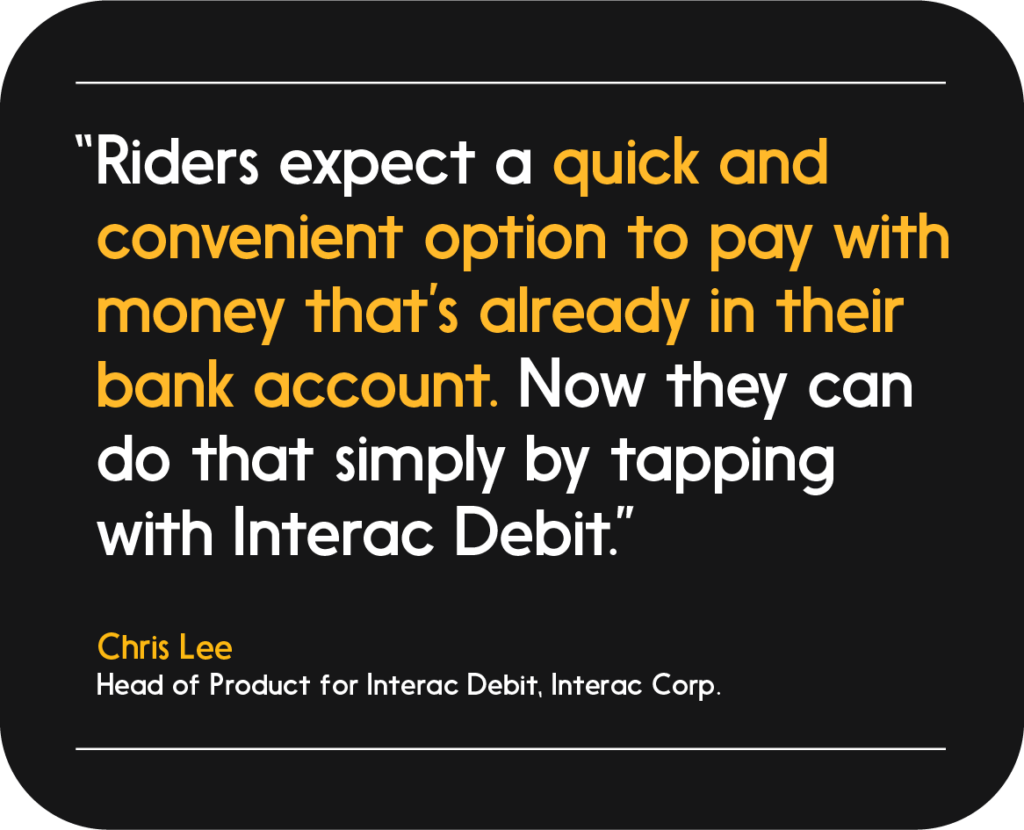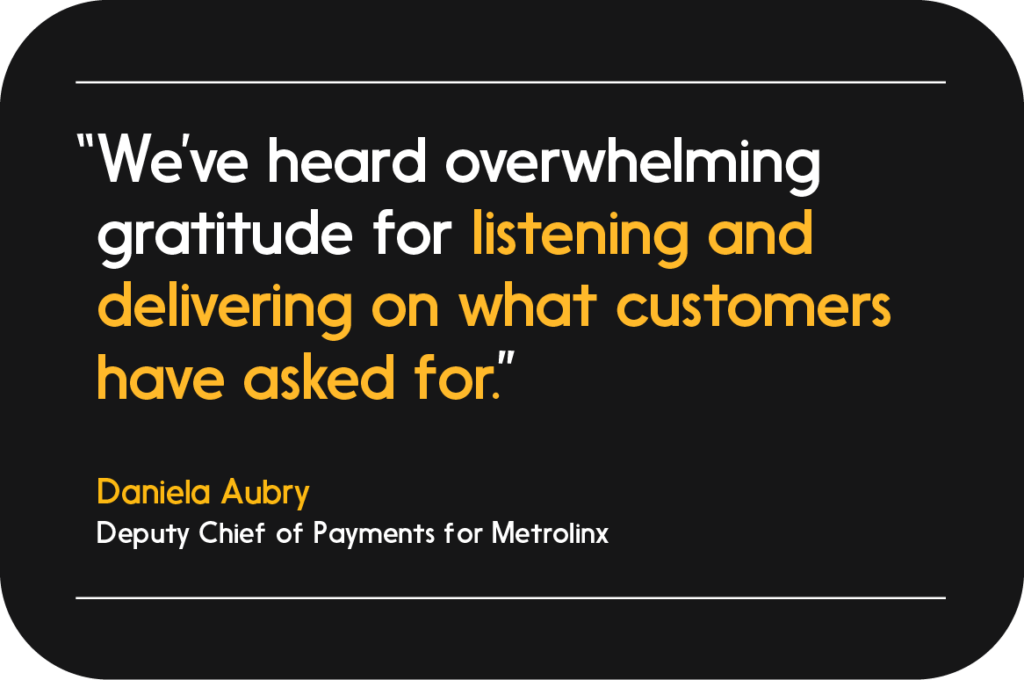There are many reasons to hope Canadians will continue choosing transit to get around as their cities keep growing. As of December 2023, urban transit ridership in Canada had reached 123 million trips, or 80 per cent of its pre-pandemic level, and to encourage more transit ridership, doing our part to make the transit payment experience quick and convenient.
Working with Interac, many transit authorities across the country are modernizing their payments systems to give riders the option to pay with money directly from their bank account. That means they can easily pay using their debit cards, mobile phones, or wearable devices — without having to carry a dedicated fare card issued by the transit authority.
Take the Greater Toronto and Hamilton Area (GTHA), for example, where Metrolinx, an agency of the Ontario government, continues its work to improve the coordination and integration of all modes of transportation. Metrolinx recently completed the rollout of PRESTO Contactless, including Interac Debit payments, across all PRESTO transit agencies in the GTHA, including the Toronto Transit Commission (TTC), as well as ParaTranspo services in Ottawa.
Chris Lee, Head, Product — Interac Debit, and Daniela Aubry, Metrolinx’s Deputy Chief of Payments, spoke about the successful rollout. Here they are in conversation.
Q: What’s driving transit organizations to modernize how riders can pay for transit?
Daniela Aubry, Metrolinx: We need to make sure the decision to take transit is as easy and convenient as possible. This means extending the ways that customers can pay for transit to match the way they make other purchases in their daily lives.
Chris Lee, Interac: Canadians have always shown an openness to adopt payment innovation to make their lives easier, and transit is no exception. Nearly seven in 10 [68 per cent] Canadians recently surveyed by Interac believe contactless payments would make paying for transit quicker and more convenient. In fact, a majority of the Canadians we polled think paying for a transit ride should be as easy as paying for a cup of coffee — and it can be.
Modernizing payments will also help transit networks in our cities become more welcoming to visitors. And for local residents who rely on transit services the most, they now have more control and choice over how they pay for their trips.
Q: What are the unique features of Interac Debit that made it a choice you wanted to offer your riders?
Aubry: At Metrolinx we’re focused on transforming the PRESTO system to adapt to ever-evolving technology and customers’ changing needs. At the same time, we also want to ensure access and equity in how customers choose to pay for public transit. For us it’s all about making transit better for everyone.
Interac Debit fits into this as it’s a payment method that most Canadians already have in their wallets, and it’s a form of payment they trust and have high confidence using.
To make paying a transit fare as easy as possible, [we supported] a payment method that customers are already using every day to pay for their other consumer needs. With Interac specifically, we know that Interac Debit is especially popular for small routine transactions, so it’s a natural fit for customers to use when paying for transit.
Lee: When transit authorities offer Interac Debit, they’re providing riders with a quick and convenient option to pay with money that’s already in their bank account — and as Daniela alluded to, it’s one that almost 30 million Canadians already use for day-to-day transactions.

Q: What can you tell us about the public reactions so far to boarding transit this way?
Aubry: Contactless payment, including Interac Debit, is a payment option we knew PRESTO customers were keen for us to provide. Since the rollout was completed to all PRESTO participating transit agencies in August, 2023, I’m thrilled to say that market uptake is actually exceeding our expectations. It now totals more than 13 per cent of all payments with PRESTO, and it reached that figure in a relatively short time. Month-over-month usage continues to grow, and as of mid-February there have been more than 35 million contactless credit and debit boardings.
We survey our customers monthly, and we regularly monitor our social media. And what we’ve heard through these sources is overwhelming gratitude for listening and delivering on what customers have asked for.
We’re constantly working to improve the customer experience. We recently launched the One Fare program, allowing riders to transfer between the TTC and connecting transit agencies while only paying one fare. The combination of fare integration with contactless payments just makes it easier and more affordable for customers to choose transit.

Q: Can you tell us a bit about what implementing Interac Debit meant, in terms of the behind-the-scenes work that goes into making this option a reality?
Aubry: Implementing a new form of payment across multiple transit agencies and modes is no easy feat. On the one hand, there’s the equipment required to enable contactless payment — nearly 13,000 devices had to be replaced. But perhaps even more significant is the fact that Metrolinx was the first transit agency in Canada to offer Interac Debit payment. And being the first at anything, especially in the technology space, comes with a certain degree of risk.
To ensure a successful customer rollout and experience we started with a pilot and then proceeded with a phased implementation. We worked closely with Interac and our transit partners on testing and collecting feedback to inform our learnings and mature the solution. Today, customers can pay and board a transit vehicle or enter a station with the speed and reliability that they expect.
Lee: We’re quickly gaining more experience with rollouts, too. We’ve now partnered with 15 transit authorities across the country to give riders a new and convenient way to pay. We’re proud to be working with transit authorities to put Canadians in charge of how they pay and move around their cities.
Q: Can you tell us about any pleasant surprises — like unexpected positive outcomes; something you didn’t think about when you set out to do this?
Aubry: When we launch new products, we always expect and plan for a customer learning curve. We know that when there are millions of people using anything new there are going to be unanticipated situations. That said, we’ve been pleasantly surprised at how smoothly the process has gone based on our customers’ feedback.
Q: In your view, what’s the larger vision around modes of urban mobility for Canadians? What does the future look like for people who are looking for convenient ways to get around in ways that don’t involve a private automobile?
Lee: In the not-too-distant future, Canadians could have the option to use multiple means of public transportation in a seamless journey by making one single payment — for example, by integrating ride- or bike-sharing services with buses, trains, subways and other modes of transportation. Digital payments will be really important in the development of these multimodal mobility services to meet the future needs of Canadians.
How do Canadians want to pay for transit in the future?





